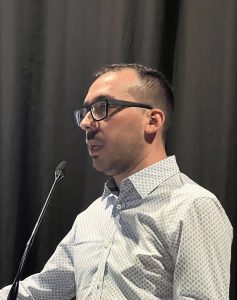As a professional journalist, Salvador Rizzo stresses how important it is to remain neutral and objective. “You can show some emotion, but can’t do more than a little,” he said. But even acclaimed reporters like him often find themselves in situations when they cannot stay silent.
During the Trump administration, when COVID-19 vaccine misinformation spread like wildfire, a family member of Rizzo’s posted false information through a private What’s App. As a professional fact checker, he couldn’t keep quiet. On impulse, he corrected a rumor she had posted in the group chat. Their relationship hasn’t been the same since.
“It was a little bit intimidating [for her] and I shouldn’t have done that because it was a bad thing for the family,” he said about correcting his cousin’s wife. “There are consequences if you confront someone for something that they believe is true. They will feel offended.”

Rizzo, a Washington Post national reporter and fact-checker, spoke at Hunter College last week about the importance of fact-checking and informing oneself as being a good news consumer.
According to Pew Research Center, 18-29 years olds with at least some college education are the highest Internet users in the U.S., and more likely to use social media. However, “they rarely read laterally to evaluate the quality of the information they encounter online,” the report said.
Rizzo’s main advice is remaining open-minded and calm around people that believe in unverified information, while also not letting emotion overpower logic. But how can a student gain the skills of a fact-checker?
Rizzo’s resilience towards misinformation reached its breaking point during Trump’s administration, which he described as “four years of falsehood.” A student at the talk was curious to find out how he stayed professional around so much misleading information. With so many “bad actors trying to manipulate people” online, accurate facts are hard to come by, he said, and students need to be capable of differentiating between true and false.
“Social media is a powerful tool to spread misinformation,” Rizzo said. In a given week, “89% of students surveyed got their news from social media,” found a Northeastern University study. The amount of students exposed to inaccurate information is exponential, and they need to be able to fact-check, he said.
Rizzo’s most important tip is to enroll in a news literacy course. Right after the Q&A portion of the talk, a student cheered, “Take the news literacy class!” Another student at the talk found that her “big takeaway was how much work goes into all of this” fact-checking.
It is vital to take this class as “news literacy is a life skill,” stressed Sissel McCarthy, head of the journalism department and one of the professors teaching the Media 211 news literacy course.
“Because there’s so much misinformation and conspiracy theories out there, right now people are not equipped to be able to discern what is factual and what is false,” she elaborated. “You really need to be taught critical thinking skills and that’s why this course is so important.”

